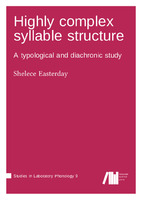Highly complex syllable structure
A typological and diachronic study
| dc.contributor.author | Easterday, Shelece | |
| dc.date.accessioned | 2020-03-10 03:00:38 | |
| dc.date.accessioned | 2020-04-01T09:14:39Z | |
| dc.date.available | 2020-04-01T09:14:39Z | |
| dc.date.issued | 2019-11-13 | |
| dc.identifier | 1006730 | |
| dc.identifier | OCN: 1229886483 | |
| dc.identifier.issn | 2363-5576 | |
| dc.identifier.uri | http://library.oapen.org/handle/20.500.12657/23420 | |
| dc.description.abstract | The syllable is a natural unit of organization in spoken language whose strongest cross-linguistic patterns are often explained in terms of a universal preference for the CV structure. Syllable patterns involving long sequences of consonants are both typologically rare and theoretically marginalized, with few approaches treating these as natural or unproblematic structures. This book is an investigation of the properties of languages with highly complex syllable patterns. The two aims are (i) to establish whether these languages share other linguistic features in common such that they constitute a distinct linguistic type, and (ii) to identify possible diachronic paths and natural mechanisms by which these patterns come about in the history of a language. These issues are investigated in a diversified sample of 100 languages, 25 of which have highly complex syllable patterns. | |
| dc.language | English | |
| dc.relation.ispartofseries | Studies in Laboratory Phonology | |
| dc.subject.classification | thema EDItEUR::C Language and Linguistics::CF Linguistics | en_US |
| dc.subject.other | Linguistics | |
| dc.title | Highly complex syllable structure | |
| dc.title.alternative | A typological and diachronic study | |
| dc.type | book | |
| oapen.identifier.doi | 10.5281/zenodo.3268721 | |
| oapen.relation.isPublishedBy | 0bad921f-3055-43b9-a9f1-ea5b2d949173 | |
| oapen.relation.isFundedBy | b818ba9d-2dd9-4fd7-a364-7f305aef7ee9 | |
| oapen.relation.isbn | 9783961101948 | |
| oapen.place.publication | Berlin | |
| oapen.grant.number | 104957 | |
| oapen.grant.program | Language Science Press 2018 - 2020 | |
| oapen.identifier.isbn | 9783961101948 | |
| grantor.number | 104957 |

